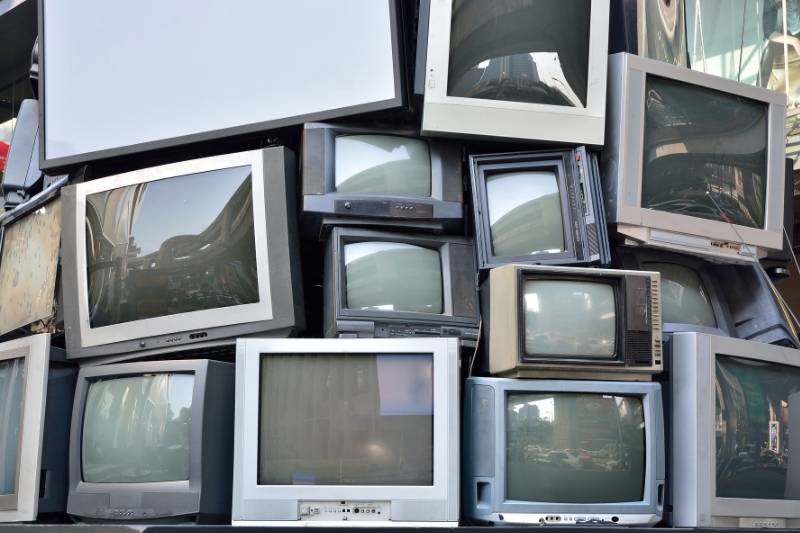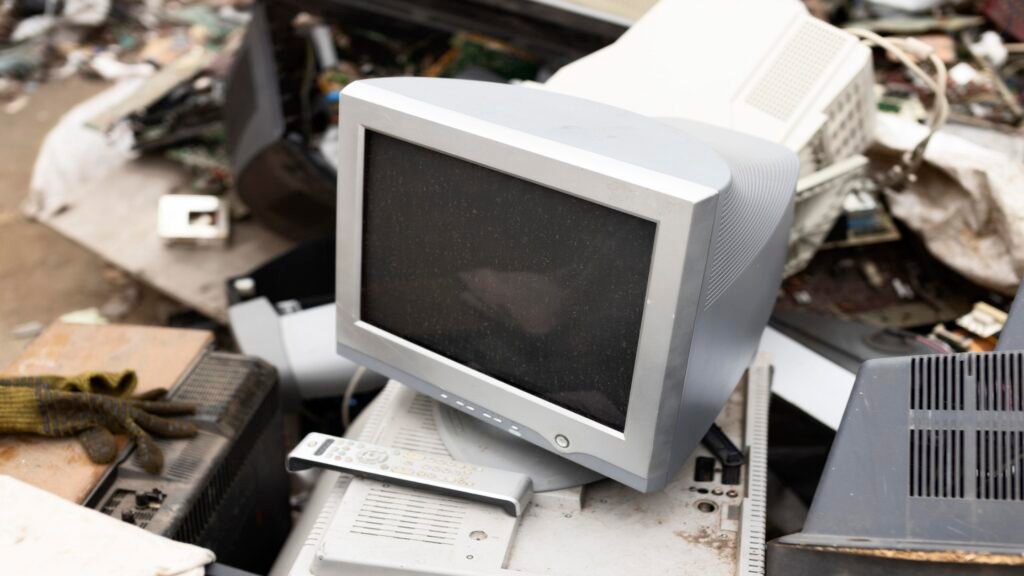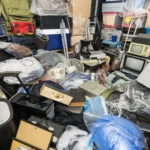Proper disposal of a broken TV is crucial for both environmental and legal reasons. TVs contain hazardous materials like lead and mercury that can harm the environment. Recycling centers and electronic waste disposal services specialize in handling these materials safely.
Some stores even offer take-back programs when you buy a new TV. Research local options to ensure you’re following regulations and protecting the environment. Proper disposal also allows for the recovery of valuable materials like metals and plastics, which can be reused. By taking these steps, you help reduce landfill waste and contribute to a more sustainable future.

Safety Measures
Disposing of a broken TV can be tricky. Safety is very important during this process. Broken TVs can have sharp edges and harmful chemicals. It’s essential to follow safety measures. This ensures you and others are safe.
Proper Handling Of Broken Tvs
Handling a broken TV needs care. First, unplug the TV from the power source. This prevents electric shocks. Always use both hands to lift the TV. Holding it firmly helps avoid drops.
Check the TV for any visible damage. Look for broken glass and exposed wires. If you see any, be extra careful. Use a thick blanket or tarp to wrap the TV. This prevents injuries from sharp edges. Secure the blanket with duct tape.
- Unplug the TV before handling.
- Use both hands to lift the TV.
- Check for broken glass or exposed wires.
- Wrap the TV in a thick blanket or tarp.
- Secure the wrapping with duct tape.
Consider using a dolly to move the TV. This reduces the risk of dropping it. If the TV is too heavy, ask for help. Two people can handle the TV better than one. Proper handling ensures safe disposal.
Wearing Protective Gear
Protective gear is vital when disposing of a broken TV. Start with gloves. Gloves protect your hands from cuts. Use safety goggles to shield your eyes. Broken glass can cause serious eye injuries.
A face mask is also important. TVs can release harmful dust and chemicals. Breathing these can be dangerous. Wear a long-sleeve shirt and long pants. This protects your skin from sharp edges and chemicals.
| Protective Gear | Purpose |
| Gloves | Protects hands from cuts |
| Safety Goggles | Shields eyes from debris |
| Face Mask | Prevents inhalation of harmful dust |
| Long-Sleeve Shirt | Protects arms from sharp edges |
| Long Pants | Protects legs from sharp edges |
Wearing the right gear keeps you safe. It minimizes the risk of injury. Always wear protective gear, no matter how small the task. Safety should be your top priority.
Check For Recycling Options
Disposing of a broken TV can be a tricky task. Simply throwing it away is not an option. TVs contain harmful materials that can damage the environment. Recycling is the best way to handle a broken TV. This article will guide you on how to check for recycling options.
Research Local Recycling Programs
First, you need to find out about local recycling programs. Many communities have special recycling days. On these days, you can drop off your broken TV. This is the safest way to get rid of it. Here are some steps to help you:
- Search online for “TV recycling near me.”
- Check your city’s website for recycling events.
- Visit local waste management centers to ask about TV recycling.
Many stores also offer recycling services. Big stores like Best Buy often have recycling programs. You might need to pay a small fee. But, it ensures the TV is disposed of safely. Some stores even offer a pick-up service. This can be very convenient if you have no way to transport the TV. Always call ahead to confirm the details.
Contact Electronic Waste Disposal Centers
Another option is to contact electronic waste disposal centers. These centers specialize in handling broken electronics. They know how to safely dispose of TVs. Here are some tips to get started:
- Search for e-waste centers in your area.
- Call the center to ask about their process.
- Ask about fees and what they accept.
Some centers might offer free disposal services. Others might charge a small fee. It’s important to ask about these details. This way, you won’t be surprised by any costs. Some centers also offer pick-up services. This can be helpful if the TV is too large to transport.
Here is a sample of questions you might ask when you call:
| Question | Reason |
| Do you accept broken TVs? | To make sure they can take your item |
| Is there a fee? | To know if you need to pay |
| Do you offer pick-up services? | To see if they can come to your home |
By taking these steps, you can ensure your broken TV is properly disposed of. It is important to keep our environment safe. Recycling is a responsible choice. Thank you for doing your part.
Donate Or Sell If Still Functional
Disposing of a broken TV can be tricky. Tossing it in the trash isn’t always the best idea. TVs contain harmful chemicals. These can harm the environment. Instead, consider donating or selling. If the TV still works, someone else might use it. This guide will show you how to donate or sell your old TV.
Find Charities Or Organizations Accepting Old Electronics
Many organizations accept old electronics. Donating your TV can help those in need.
Here are some places to consider:
- Goodwill: Goodwill accepts working electronics. They sell them to fund their programs.
- Salvation Army: This group also takes working electronics. They use the sales to support their services.
- Local schools or community centers: Some schools and centers need TVs for educational purposes.
Before donating, check the condition of your TV. Make sure it is still functional. Many places won’t accept broken TVs. Call ahead to confirm they can take it. This saves you time and effort.
Some other tips for donating:
- Clean the TV before donating.
- Include any remotes or cables.
- Provide the manual if you still have it.
Donating your TV can make a big difference. It helps the environment and those in need.
Online Platforms For Selling Used Electronics
Selling your old TV online is a great option. Many platforms make this easy.
Here are a few to consider:
- eBay: eBay lets you list your TV for sale. You can set a price or auction it.
- Craigslist: Craigslist is a local classifieds site. You can list your TV for free.
- Facebook Marketplace: This platform connects you with local buyers. It’s easy to use and popular.
When listing your TV, be honest about its condition. Take clear photos. Describe any issues. This helps buyers know what to expect.
Some tips for selling online:
- Research prices for similar TVs.
- Set a fair price.
- Respond quickly to messages from buyers.
These platforms make it easy to sell your TV. You can earn some money and help someone else. Plus, it keeps your old TV out of the landfill.
Disassemble The TV
Disposing of a broken TV can seem tricky. But, with the right steps, it becomes simple. One crucial step is to disassemble the TV. This process involves breaking down the TV into smaller parts. This makes it easier to recycle or throw away each piece. Doing this helps keep harmful materials from hurting the environment.
Gather Necessary Tools
Before starting to disassemble the TV, gather all necessary tools. Having the right tools makes the job easier and safer.
Here are some tools you will need:
- Screwdrivers (both flat-head and Phillips)
- Pliers
- Wire cutters
- Gloves to protect your hands
- Safety glasses
Using the right tools ensures you can take apart the TV without damaging parts. Gloves and safety glasses protect you from sharp edges or broken glass. Screwdrivers help remove screws holding the TV together. Pliers and wire cutters help cut and pull out wires.
Make sure to have a clean workspace. This helps keep track of parts and tools. A good workspace also prevents losing small screws and components. With everything ready, you are set to start disassembling the TV.
Step-by-step Disassembly Process
Follow these steps to disassemble the TV. First, unplug the TV and place it on a flat surface. This prevents electric shocks and ensures stability. Second, remove the screws from the back panel using a screwdriver. Keep the screws in a safe place.
Third, gently lift the back panel to expose the inner components. Be careful not to break any parts. Fourth, identify and remove the circuit boards. Use pliers to disconnect any wires attached. Fifth, remove the speakers if your TV has them. Use a screwdriver to unscrew them from the frame.
Sixth, take out the screen carefully. The screen is usually attached with screws or clips. Seventh, remove any remaining parts like the power supply and buttons. Place all components in separate bags or boxes for recycling or disposal.
Following these steps helps you safely break down the TV. Always remember to handle components with care. Some parts can be fragile. Disassembling the TV this way ensures you can dispose of each part properly.
Properly Dispose Of Components
Broken TVs can be a problem. Proper disposal helps the environment. This guide will teach you how to properly dispose of TV components.
Separate And Sort Components
Start by separating the TV parts. This makes recycling easier. First, remove the back cover. You will see various parts inside. Take out the circuit boards, cables, and speakers. These items can be recycled separately. Next, remove the screen. Screens contain chemicals and need special handling.
Here are steps to separate components:
- Unscrew the back cover.
- Remove circuit boards.
- Disconnect cables.
- Take out speakers.
- Detach the screen.
Always handle with care. Some parts can be sharp. Wear gloves for protection. Sorting helps make recycling faster. Separate metal, plastic, and electronic parts. Place each type in a different box or bag. Label them clearly.
Recycle Or Dispose Of Hazardous Materials
TVs have hazardous materials. These include lead, mercury, and cadmium. These materials can harm the environment. Take these to special recycling centers. Many cities have e-waste programs. Check your local waste management website for details.
Do not throw hazardous materials in the trash. This can cause pollution.
Use the following guide to recycle:
| Material | How to Dispose |
| Lead | Take to e-waste center |
| Mercury | Special recycling facility |
| Cadmium | Electronic recycling program |
Some stores offer recycling services. Call ahead to see if they accept TVs. Proper disposal protects our planet. Make sure to follow local rules. This helps keep our environment clean and safe.
6. Dispose Of The TV
A broken TV can be a hassle. It’s big, heavy, and full of hazardous materials. Proper disposal is important to protect the environment and avoid fines. This guide will help you with the steps to dispose of your broken TV safely and legally.
Choose Appropriate Disposal Method
There are several methods to dispose of a broken TV. Recycling is one of the best ways. Many electronics stores offer recycling programs. You can also take it to a local recycling center.
Another option is e-waste collection events. Cities often host these events to collect old electronics. Check your city’s website for details.
Some people prefer to donate their broken TV. Many charities accept broken electronics for parts. Make sure to call ahead and check if they accept broken TVs.
Here are some disposal methods:
- Recycle at electronics stores
- Take to local recycling centers
- Attend e-waste collection events
- Donate to charities
Follow Local Regulations
It’s crucial to follow local regulations when disposing of your TV. Each city has its own rules for electronic waste. Check your city’s website for information.
Some cities have curbside pickup programs for e-waste. You may need to schedule a pickup or use a special bag. Other cities have drop-off locations for electronics.
Fines may apply if you don’t follow the rules. Improper disposal can harm the environment and your wallet. Always check the regulations to avoid trouble.
Here are some tips for following local regulations:
- Check your city’s website for e-waste rules
- Use curbside pickup if available
- Take your TV to a designated drop-off location
Conclusion
Properly disposing of a broken TV benefits the environment and your community. Follow local guidelines and recycle responsibly. Consider donating or repurposing usable parts. Always avoid illegal dumping to prevent harm. By taking these steps, you contribute to a cleaner, safer planet for future generations.







